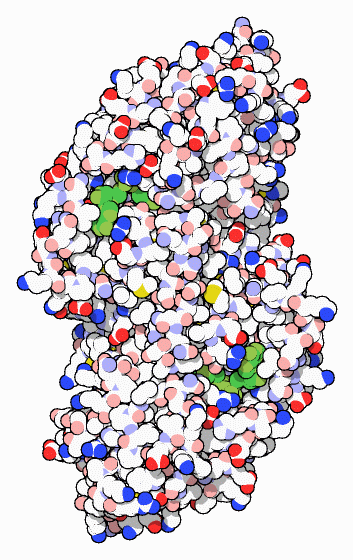|
Inhaltsübersicht | Nanomaschinen | Moleküle | Programme | Kurse | Fun | Links |
||
| > |
Alkohol Dehydrogenase

Here's a toast to alcohol dehydrogenase. While recovering from the excesses of New Year's Eve, we might ponder the enzyme that ceaselessly battles the champagne that we consume. Alcohol dehydrogenase is our primary defense against alcohol, a toxic molecule that compromises the function of our nervous system. The high levels of alcohol dehydrogenase in our liver and stomach detoxify about one stiff drink each hour. The alcohol is converted to acetaldehyde, an even more toxic molecule, which is then quickly converted into acetate and other molecules that are easily utilized by our cells. Thus, a potentially dangerous molecule is converted, through alcohol dehydrogenase, into a mere foodstuff.
Forms and Functions
Our bodies create at least nine different forms of alcohol dehydrogenase, each with slightly different properties. Most of these are found primarily in the liver, including the beta3 form (PDB entry 1htb) and the similar enzyme from horse liver (PDB entry 6adh). The sigma form, available in PDB entry 1agn, is found in the lining of the stomach. Each enzyme is composed of two subunits, and quite remarkably, you can mix and match subunits between these different forms, creating mixed dimers that are still active. Ethanol is not the only target of these enzymes, they also make important modifications to retinol, steroids, and fatty acids. The range of different types of alcohol dehydrogenase ensures that there will always be one that is perfect for the current task.
Consequences
Alcohol dehydrogenase provides a line of defense against a common toxin in our environment. But this protection carries with it some dangers. Alcohol dehydrogenase also modifies other alcohols, often producing dangerous products. For instance, methanol, which is commonly used to "denature" ethanol rendering it undrinkable, is converted into formaldehyde by alcohol dehydrogenase. The formaldehyde then does the damage, attacking proteins and embalming them. Small amounts of methanol cause blindness, as the sensitive proteins in the retina are attacked, and larger amounts, perhaps a glassful, lead to widespread damage and death.
Next: Making Alcohol
Last changed by: A.Honegger,